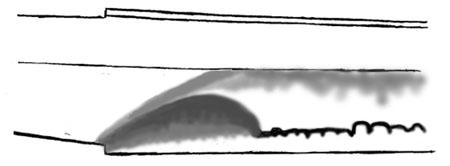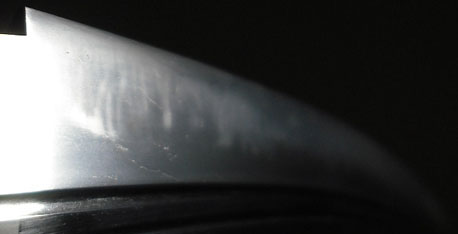By lyuesword | 01 July 2022 | 0 Comments
Yakiotoshi and Koshiba Ⅱ
Koshiba
It is a fantastic effect of sensitive steel on hardening work. The appearance is that the start of hamon rises wide following the utsuri, the hamon particles are thin there, then the hamon becomes lower with dense particles.

The less of hardening effect at the starting of hamon makes it wide naturally, but with thin particles. It can be seen only on good blades in 12th century or 13th century. It is unexpcted appearance for the smith, but not failure for blade. It shows us a wonder of sensitive steel on hardening. We appreciate it very much, but rare to find. For example, Ko-bizen, Ichimonji, Awataguchi Kunitsuna. The koshiba is never found on later smiths' work. They made well ordered hamon from the ha-machi to the kissaki.
[An example of koshiba, but not very clear.]

Some smiths in 15th century copied the koshiba pattern by clay designing. Such hamon also is called koshiba, but only a meaning of a kind of hamon patterns. For example, Muramasa, Kanesada in Seki.
Want a unique sword? Feel free to contact us:
Email: lyuesword@hotmail.com
Website: www.lyuesword.com
Custom Sword Page: www.lyuesword.com/Custom-Sword/customization-options/Create-Your-Own-Swords
It is a fantastic effect of sensitive steel on hardening work. The appearance is that the start of hamon rises wide following the utsuri, the hamon particles are thin there, then the hamon becomes lower with dense particles.

The less of hardening effect at the starting of hamon makes it wide naturally, but with thin particles. It can be seen only on good blades in 12th century or 13th century. It is unexpcted appearance for the smith, but not failure for blade. It shows us a wonder of sensitive steel on hardening. We appreciate it very much, but rare to find. For example, Ko-bizen, Ichimonji, Awataguchi Kunitsuna. The koshiba is never found on later smiths' work. They made well ordered hamon from the ha-machi to the kissaki.
[An example of koshiba, but not very clear.]

Some smiths in 15th century copied the koshiba pattern by clay designing. Such hamon also is called koshiba, but only a meaning of a kind of hamon patterns. For example, Muramasa, Kanesada in Seki.
Want a unique sword? Feel free to contact us:
Email: lyuesword@hotmail.com
Website: www.lyuesword.com
Custom Sword Page: www.lyuesword.com/Custom-Sword/customization-options/Create-Your-Own-Swords
Leave a Reply
Your email address will not be published.Required fields are marked. *